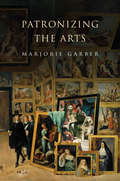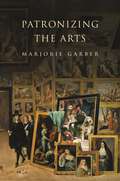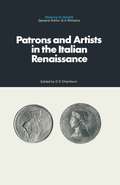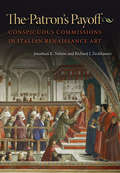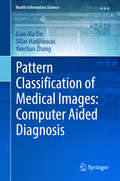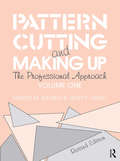- Table View
- List View
Patronage in the Renaissance
by Guy Fitch Lytle Stephen OrgelThe fourteen essays in this collection explore the dominance of patronage in Renaissance politics, religion, theatre, and artistic life.Originally published in 1982.The Princeton Legacy Library uses the latest print-on-demand technology to again make available previously out-of-print books from the distinguished backlist of Princeton University Press. These editions preserve the original texts of these important books while presenting them in durable paperback and hardcover editions. The goal of the Princeton Legacy Library is to vastly increase access to the rich scholarly heritage found in the thousands of books published by Princeton University Press since its founding in 1905.
Patronizing the Arts
by Marjorie GarberWhat is the role of the arts in American culture? Is art an essential element? If so, how should we support it? Today, as in the past, artists need the funding, approval, and friendship of patrons whether they are individuals, corporations, governments, or nonprofit foundations. But as Patronizing the Arts shows, these relationships can be problematic, leaving artists "patronized"--both supported with funds and personal interest, while being condescended to for vocations misperceived as play rather than serious work. In this provocative book, Marjorie Garber looks at the history of patronage, explains how patronage has elevated and damaged the arts in modern culture, and argues for the university as a serious patron of the arts. With clarity and wit, Garber supports rethinking prejudices that oppose art's role in higher education, rejects assumptions of inequality between the sciences and humanities, and points to similarities between the making of fine art and the making of good science. She examines issues of artistic and monetary value, and transactions between high and popular culture. She even asks how college sports could provide a new way of thinking about arts funding. Using vivid anecdotes and telling details, Garber calls passionately for an increased attention to the arts, not just through government and private support, but as a core aspect of higher education. Compulsively readable, Patronizing the Arts challenges all who value the survival of artistic creation both in the present and future.
Patronizing the Arts
by Marjorie GarberWhat is the role of the arts in American culture? Is art an essential element? If so, how should we support it? Today, as in the past, artists need the funding, approval, and friendship of patrons whether they are individuals, corporations, governments, or nonprofit foundations. But as Patronizing the Arts shows, these relationships can be problematic, leaving artists "patronized"--both supported with funds and personal interest, while being condescended to for vocations misperceived as play rather than serious work. In this provocative book, Marjorie Garber looks at the history of patronage, explains how patronage has elevated and damaged the arts in modern culture, and argues for the university as a serious patron of the arts. With clarity and wit, Garber supports rethinking prejudices that oppose art's role in higher education, rejects assumptions of inequality between the sciences and humanities, and points to similarities between the making of fine art and the making of good science. She examines issues of artistic and monetary value, and transactions between high and popular culture. She even asks how college sports could provide a new way of thinking about arts funding. Using vivid anecdotes and telling details, Garber calls passionately for an increased attention to the arts, not just through government and private support, but as a core aspect of higher education. Compulsively readable, Patronizing the Arts challenges all who value the survival of artistic creation both in the present and future.
Patronizing the Arts
by Marjorie GarberWhat is the role of the arts in American culture? Is art an essential element? If so, how should we support it? Today, as in the past, artists need the funding, approval, and friendship of patrons whether they are individuals, corporations, governments, or nonprofit foundations. But as Patronizing the Arts shows, these relationships can be problematic, leaving artists "patronized"--both supported with funds and personal interest, while being condescended to for vocations misperceived as play rather than serious work. In this provocative book, Marjorie Garber looks at the history of patronage, explains how patronage has elevated and damaged the arts in modern culture, and argues for the university as a serious patron of the arts. With clarity and wit, Garber supports rethinking prejudices that oppose art's role in higher education, rejects assumptions of inequality between the sciences and humanities, and points to similarities between the making of fine art and the making of good science. She examines issues of artistic and monetary value, and transactions between high and popular culture. She even asks how college sports could provide a new way of thinking about arts funding. Using vivid anecdotes and telling details, Garber calls passionately for an increased attention to the arts, not just through government and private support, but as a core aspect of higher education. Compulsively readable, Patronizing the Arts challenges all who value the survival of artistic creation both in the present and future.
Patronizing the Arts
by Marjorie GarberWhat is the role of the arts in American culture? Is art an essential element? If so, how should we support it? Today, as in the past, artists need the funding, approval, and friendship of patrons whether they are individuals, corporations, governments, or nonprofit foundations. But as Patronizing the Arts shows, these relationships can be problematic, leaving artists "patronized"--both supported with funds and personal interest, while being condescended to for vocations misperceived as play rather than serious work. In this provocative book, Marjorie Garber looks at the history of patronage, explains how patronage has elevated and damaged the arts in modern culture, and argues for the university as a serious patron of the arts. With clarity and wit, Garber supports rethinking prejudices that oppose art's role in higher education, rejects assumptions of inequality between the sciences and humanities, and points to similarities between the making of fine art and the making of good science. She examines issues of artistic and monetary value, and transactions between high and popular culture. She even asks how college sports could provide a new way of thinking about arts funding. Using vivid anecdotes and telling details, Garber calls passionately for an increased attention to the arts, not just through government and private support, but as a core aspect of higher education. Compulsively readable, Patronizing the Arts challenges all who value the survival of artistic creation both in the present and future.
The Patron's Payoff: Conspicuous Commissions in Italian Renaissance Art
by Jonathan K. Nelson Richard J. Zeckhauser Michael SpenceIn The Patron's Payoff, Jonathan Nelson and Richard Zeckhauser apply the innovative methods of information economics to the study of art. Their findings, written in highly accessible prose, are surprising and important. Building on three economic concepts--signaling, signposting, and stretching--the book develops the first systematic methodology for assessing the meaning of art patronage and provides a broad and useful framework for understanding how works of art functioned in Renaissance Italy.The authors discuss how patrons used conspicuous commissions to establish and signal their wealth and status, and the book explores the impact that individual works had on society. The ways in which artists met their patrons' needs for self-promotion dramatically affected the nature and appearance of paintings, sculptures, and buildings. The Patron's Payoff presents a new conceptual structure that allows readers to explore the relationships among the main players in the commissioning game--patrons, artists, and audiences--and to understand how commissioned art transmits information. This book facilitates comparisons of art from different periods and shows the interplay of artists and patrons working to produce mutual benefits subject to an array of limiting factors. The authors engage several art historians to look at what economic models reveal about the material culture of Italy, ca. 1300�1600, and beyond. Their case studies address such topics as private chapels and their decorations, donor portraits, and private palaces.In addition to the authors, the contributors are Molly Bourne, Kelley Helmstutler Di Dio, Thomas J. Loughman, and Larry Silver.
Pattern: & the secrets of lasting design
by Emma BridgewaterThis is the black and white paperback edition of Pattern, published in hardback in 2016 by Saltyard Books.If you would like the original colour illustrated version of Pattern it is available in hardback ISBN 9781444734942. Creativity, collaboration, inspirationEmma Bridgewater's patterns are as quintessentially British as marmalade on toast - and they have made her distinctive homewares best sellers across the world.Her inspiration is often deeply personal - a plate of her mother's, a favourite children's book - and as she tells the stories of each pattern's creation, she reveals the intricate processes of research and collaboration behind the familiar designs she has stamped on our kitchenware - and our hearts - for the past thirty years.Both an entrancing trip down memory lane and a behind-the-scenes look at a thriving creative business, Emma Bridgewater's PATTERN is essential reading for anyone who has ever turned over their mug after draining their tea and wondered about the human story behind that proud declaration: Made in Stoke-on-Trent, England...
Pattern: (mini Edition)
by Orla KielyThe world of Orla Kiely is one where pattern reigns. Immediately recognisable, her unique design language and sure sense of graphic control has seen her label become a hugely successful global brand in the decade since its launch. From her early signature bags, the collection has grown to include a complete womenswear line, accessories, travel and homeware, sold in shops and outlets worldwide.Giving a personal account of what informs her work and inspires her designs, Orla looks at pattern in all its manifestations - the impact of scale and proportion, rhythm and texture and the all-important dimension of colour. With her prints applied to a wide range of products, from bags and clothing to decorative objects and soft furnishings, she is in a unique position to comment on all the ways in which pattern can enrich our lives. Illustrated with many examples of Orla's work, along with inspirational images that have shaped her style, the result is both a visual treasury and a thoughtful guide to using pattern with flair and confidence.
The Pattern 1853 Enfield Rifle (Weapon)
by Peter Dennis Peter SmithurstThe Pattern 1853 Enfield Rifle was the first rifled firearm issued to every soldier in the British Army, and gave the infantry a revolutionary increase in firepower. First issued in 1853, the Enfield proved itself worthy during both the Crimean War and the Indian Mutiny, where its long range, durability, and interchangeable parts made it a perfect campaign rifle. However, it was during the American Civil War that the Enfield saw the greatest use, with over a million rifles being sold to the armies of both the North and South. This title takes an in-depth look at the design, the history, the mechanics, and the use of one of the most important firearms of the 19th century.
The Pattern 1853 Enfield Rifle (Weapon #10)
by Peter SmithurstThe Pattern 1853 Enfield Rifle was the first rifled firearm issued to every soldier in the British Army, and gave the infantry a revolutionary increase in firepower. First issued in 1853, the Enfield proved itself worthy during both the Crimean War and the Indian Mutiny, where its long range, durability, and interchangeable parts made it a perfect campaign rifle. However, it was during the American Civil War that the Enfield saw the greatest use, with over a million rifles being sold to the armies of both the North and South. This title takes an in-depth look at the design, the history, the mechanics, and the use of one of the most important firearms of the 19th century.
Pattern Analysis (Springer Series in Information Sciences #4)
by H. NiemannThis book is devoted to pattern analysis, that is, the automatic construc tion of a symbolic description for a complex pattern, like an image or con nected speech. Pattern analysis thus tries to simulate certain capabilities which go without saying in any human central nervous system. The increasing interest and growing efforts at solving the problems related with pattern analysis are motivated by the challenge of the problem and the expected ap plications. Potential applications are numerous and result from the fact that data can be gathered and stored by modern devices in ever increasing extent, thus making the finding of particular interesting facts or events in these hosts of data an ever increasing problem. It was tried to organize the book around one particular view of pattern analysis: the view that pattern analysis requires an appropriate set of modules operating on a common data base which contains interme processing diate results of processing. Although other views are certainly possible, this one was adopted because the author feels that it is a useful idea, be cause the size of this book had to be kept within reasonable bounds, and because it facilitated the composition of fairly self-contained chapters.
Pattern Analysis and Understanding (Springer Series in Information Sciences #4)
by Heinrich NiemannIn this second edition every chapter of the first edition of Pattern Analysis has been updated and expanded. The general view of a system for pattern analysis and understanding has remained unchanged, but many details have been revised. A short account of light and sound has been added to the introduction, some normalization techniques and a basic introduction to morphological operations have been added to the second chapter. Chapter 3 has been expanded significantly by topics like motion, depth, and shape from shading; additional material has also been added to the already existing sections of this chapter. The old sections of Chap. 4 have been reorganized, a general view of the classification problem has been added and material provided to incorporate techniques of word and object recognition and to give a short account of some types of neural nets. Almost no changes have been made in Chap. 5. The part on representation of control structures in Chap. 6 has been shortened, a section on the judgement of results has been added. Chapter 7 has been rewritten almost completely; the section on formal grammars has been reduced, the sections on production systems, semantic networks, and knowledge acquisition have been expanded, and sections on logic and explanation added. The old Chaps. 8 and 9 have been omitted. In summary, the new edition is a thorough revision and extensive update of the first one taking into account the progress in the field during recent years.
Pattern Classification of Medical Images: Computer Aided Diagnosis (Health Information Science)
by Xiao-Xia Yin Sillas Hadjiloucas Yanchun ZhangThis book presents advances in biomedical imaging analysis and processing techniques using time dependent medical image datasets for computer aided diagnosis. The analysis of time-series images is one of the most widely appearing problems in science, engineering, and business. In recent years this problem has gained importance due to the increasing availability of more sensitive sensors in science and engineering and due to the wide-spread use of computers in corporations which have increased the amount of time-series data collected by many magnitudes. An important feature of this book is the exploration of different approaches to handle and identify time dependent biomedical images. Biomedical imaging analysis and processing techniques deal with the interaction between all forms of radiation and biological molecules, cells or tissues, to visualize small particles and opaque objects, and to achieve the recognition of biomedical patterns. These are topics of great importance to biomedical science, biology, and medicine. Biomedical imaging analysis techniques can be applied in many different areas to solve existing problems. The various requirements arising from the process of resolving practical problems motivate and expedite the development of biomedical imaging analysis. This is a major reason for the fast growth of the discipline.
Pattern Cutting (Portfolio Skills)
by Dennic Chunman LoThis practical book shows students how to interpret the human form and look at clothing through the eyes of a designer rather than a consumer. As well as explaining the proportions of human anatomy, the book introduces key tools and takes the reader from simple pattern-cutting ideas to more advanced creative methods. Step-by-step illustrations show how to create basic bodice, sleeve, skirt, dress and trouser blocks, and how to adapt these to create patterns for original designs. There is also a chapter dedicated to digital technology, and a selection of the author’s own creative designs encourages experimentation with the potential of pattern cutting.
Pattern Cutting: Second Edition
by Dennic Chunman LoThis practical guide explains how to take accurate measurements, introduces key tools and takes you from simple pattern-cutting ideas to more advanced creative methods. Step-by-step illustrations show how to create and then fit basic bodice, sleeve, skirt, dress, and trouser blocks, and how to adapt these to create patterns for original designs. New material includes advice on fitting toiles and working with stretch fabrics. There is also a fully updated chapter dedicated to digital technology.New to this edition: Access to 32 instructional videos
Pattern Cutting and Making Up
by Janet Ward Martin ShobenMajor changes have occurred in the last few years in the methods of cutting and manufacturing outerwear. Light clothing companies are now manufacturing these heavy garments because of the development of fusible interlinings and new manufacturing techniques which have resulted in the deskilling of traditional tailoring methods. Outerwear has consquently assumed much greater importance in light clothing courses and this book - the first of its kind - has been written to reflect these industrial changes. It offers a course of practical and theoretical study which is related to specific garment types and fabrics. An essential manual for students at every level. Suitable for use in CGLI, BTEC and degree courses, this uniquely comprehensive work is certain to become a standard textbook on its subject.
Pattern Cutting and Making Up
by Janet Ward Martin ShobenMajor changes have occurred in the last few years in the methods of cutting and manufacturing outerwear. Light clothing companies are now manufacturing these heavy garments because of the development of fusible interlinings and new manufacturing techniques which have resulted in the deskilling of traditional tailoring methods. Outerwear has consquently assumed much greater importance in light clothing courses and this book - the first of its kind - has been written to reflect these industrial changes. It offers a course of practical and theoretical study which is related to specific garment types and fabrics. An essential manual for students at every level. Suitable for use in CGLI, BTEC and degree courses, this uniquely comprehensive work is certain to become a standard textbook on its subject.
Pattern Cutting: The Architecture of Fashion
by Pat ParishPattern cutting, or pattern making, is an essential yet complex skill for every fashion designer to master. Pattern Cutting: The Architecture of Fashion demystifies the pattern cutting process and clearly demonstrates pattern fundamentals, enabling you to construct in both 2D and 3D, and quickly get to grips with basic blocks, shape, sleeves, collars, trousers, pockets and finishes.Pat Parish approaches the subject of pattern cutting through proportion, balance, line and form, identifying key shapes and structures from the catwalk and translating them into 3D through cutting, draping and construction processes. This popular and inspirational sourcebook has been updated to reflect new directions in construction design and techniques, and to include more advanced patterns, such as the Magyar sleeve and the jumpsuit.With handy tips, shortcuts and tricks of the trade, the second edition of Pattern Cutting is a must-have studio resource for all budding fashion designers. It will provide you with the inspiration, tools and confidence to interpret and adapt basic patterns, and take your designs to the next level.New to this edition- Step-by-step instructions for more complex patterns, including the Magyar sleeve, rever collar and jumpsuit- A chapter devoted to patterns for pockets and finishes- Invaluable information about working with different fabrics, such as neoprene and spacer- Expanded coverage of innovation in pattern cutting, including sustainable and geometric cutting techniques- Refreshed pattern flats and colour images - Case studies with designers who have used cutting techniques to create unique, contemporary designs
Pattern Cutting: The Architecture of Fashion
by Pat ParishPattern cutting, or pattern making, is an essential yet complex skill for every fashion designer to master. Pattern Cutting: The Architecture of Fashion demystifies the pattern cutting process and clearly demonstrates pattern fundamentals, enabling you to construct in both 2D and 3D, and quickly get to grips with basic blocks, shape, sleeves, collars, trousers, pockets and finishes.Pat Parish approaches the subject of pattern cutting through proportion, balance, line and form, identifying key shapes and structures from the catwalk and translating them into 3D through cutting, draping and construction processes. This popular and inspirational sourcebook has been updated to reflect new directions in construction design and techniques, and to include more advanced patterns, such as the Magyar sleeve and the jumpsuit.With handy tips, shortcuts and tricks of the trade, the second edition of Pattern Cutting is a must-have studio resource for all budding fashion designers. It will provide you with the inspiration, tools and confidence to interpret and adapt basic patterns, and take your designs to the next level.New to this edition- Step-by-step instructions for more complex patterns, including the Magyar sleeve, rever collar and jumpsuit- A chapter devoted to patterns for pockets and finishes- Invaluable information about working with different fabrics, such as neoprene and spacer- Expanded coverage of innovation in pattern cutting, including sustainable and geometric cutting techniques- Refreshed pattern flats and colour images - Case studies with designers who have used cutting techniques to create unique, contemporary designs
Pattern Cutting for Men's Costume (Backstage)
by Elizabeth FriendshipPattern Cutting for Men's Costume is a practicalguide featuring patterns for the most important garments worn by menbetween the 16th and 19th centuries. Easy-to-follow instructionsexplain how to cut patterns for 'average' and individual measurements -with expert advice on how to adapt patterns to fit men of all shapesand sizes.Introductions to each section describe the major developments inmen's dress - revealing how garments evolved - and patterns for periodgarments for which there are no actual examples are based oncontemporary paintings. Illustrated throughout with hundreds ofdiagrams, this is a much-awaited and valuable addition to the libraryof costume-makers in all fields.Features a new system of drafting patterns for men's period costume.Includes patterns for the most important non-fashionable garments(worn from the 16th to the 19th centuries) plus clothes in vogue fromthe middle of the 16th to the end of the 18th centuries.Illustrated with hundreds of diagrams accompanied by step-by-stepinstructions for period garments, plus a few versatile theatricaldesigns.
Pattern Cutting for Men's Costume (Backstage)
by Elizabeth FriendshipPattern Cutting for Men's Costume is a practicalguide featuring patterns for the most important garments worn by menbetween the 16th and 19th centuries. Easy-to-follow instructionsexplain how to cut patterns for 'average' and individual measurements -with expert advice on how to adapt patterns to fit men of all shapesand sizes.Introductions to each section describe the major developments inmen's dress - revealing how garments evolved - and patterns for periodgarments for which there are no actual examples are based oncontemporary paintings. Illustrated throughout with hundreds ofdiagrams, this is a much-awaited and valuable addition to the libraryof costume-makers in all fields.Features a new system of drafting patterns for men's period costume.Includes patterns for the most important non-fashionable garments(worn from the 16th to the 19th centuries) plus clothes in vogue fromthe middle of the 16th to the end of the 18th centuries.Illustrated with hundreds of diagrams accompanied by step-by-stepinstructions for period garments, plus a few versatile theatricaldesigns.
Pattern Cutting for Menswear
by Gareth KershawDesigned for both students and professionals, Pattern Cutting for Menswear offers a comprehensive guide to pattern cutting from the basic skills through to advanced techniques. Including 20 complete patterns that show how to cut every aspect of menswear, the book features adaptations from basic blocks through to classic garments and trend-led styles. Illustrated throughout, this book contains everything you need to know to cut patterns for today’s menswear market. Using a step-by-step approach, illustrated with accurately sized and scaled flat diagrams, technical flats and fashion illustrations and photographs of toiles, Pattern Cutting for Menswear explains the theory behind the practice, enabling the reader to cut patterns with confidence.
Pattern Cutting for Menswear
by Gareth KershawDesigned for both students and professionals, this book offers a comprehensive guide to patternmaking for menswear from the basic skills through to more advanced techniques. The book includes 20 complete patterns that show how to cut every aspect of the menswear including adaptations from basic slopers through to classic garments and trend-led styles. Using a step-by-step approach, illustrated with accurately sized and scaled flat diagrams, technical flats and fashion illustrations, and photographs of muslins, it explains the theory behind the practice enabling the reader to understand how to cut patterns with confidence. Illustrated throughout, this book contains everything you need to know to make patterns for today’s menswear market.
Pattern Cutting for Menswear: Second Edition
by Gareth KershawPattern Cutting for Menswear is a comprehensive guide to cutting patterns, from basic skills to advanced techniques. With over twenty complete patterns, including new jacket and trouser styles, this revised edition features additional sections on the leg stride relationship in the development of certain trouser styles, fabric properties and their effect on cut and drape, fitting techniques for structured jackets, and the latest information on pattern CAD-based technologies. The step-by-step approach, complete with scaled diagrams and technical flats, fashion illustrations and photographs of toiles, enables you to cut patterns with confidence.

